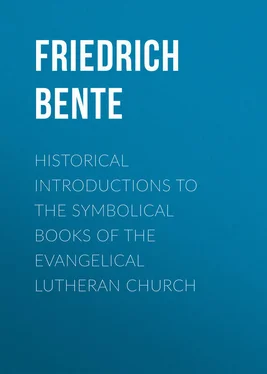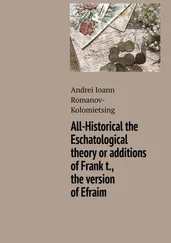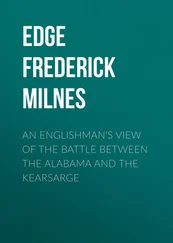Friedrich Bente - Historical Introductions to the Symbolical Books of the Evangelical Lutheran Church
Здесь есть возможность читать онлайн «Friedrich Bente - Historical Introductions to the Symbolical Books of the Evangelical Lutheran Church» — ознакомительный отрывок электронной книги совершенно бесплатно, а после прочтения отрывка купить полную версию. В некоторых случаях можно слушать аудио, скачать через торрент в формате fb2 и присутствует краткое содержание. ISBN: , Жанр: foreign_antique, foreign_prose, на английском языке. Описание произведения, (предисловие) а так же отзывы посетителей доступны на портале библиотеки ЛибКат.
- Название:Historical Introductions to the Symbolical Books of the Evangelical Lutheran Church
- Автор:
- Жанр:
- Год:неизвестен
- ISBN:http://www.gutenberg.org/ebooks/26909
- Рейтинг книги:3 / 5. Голосов: 1
-
Избранное:Добавить в избранное
- Отзывы:
-
Ваша оценка:
- 60
- 1
- 2
- 3
- 4
- 5
Historical Introductions to the Symbolical Books of the Evangelical Lutheran Church: краткое содержание, описание и аннотация
Предлагаем к чтению аннотацию, описание, краткое содержание или предисловие (зависит от того, что написал сам автор книги «Historical Introductions to the Symbolical Books of the Evangelical Lutheran Church»). Если вы не нашли необходимую информацию о книге — напишите в комментариях, мы постараемся отыскать её.
Historical Introductions to the Symbolical Books of the Evangelical Lutheran Church — читать онлайн ознакомительный отрывок
Ниже представлен текст книги, разбитый по страницам. Система сохранения места последней прочитанной страницы, позволяет с удобством читать онлайн бесплатно книгу «Historical Introductions to the Symbolical Books of the Evangelical Lutheran Church», без необходимости каждый раз заново искать на чём Вы остановились. Поставьте закладку, и сможете в любой момент перейти на страницу, на которой закончили чтение.
Интервал:
Закладка:
Nathanael confessed: "Rabbi, Thou art the Son of God; Thou art the King of Israel," John 1, 49, the apostles confessed: "Thou art the Christ, the Son of the living God," Matt. 16, 16; Peter confessed: "We believe and are sure that Thou art that Christ, the Son of the living God," John 6, 69; Thomas confessed: "My Lord and my God," John 20, 28. These and similar confessions of the truth concerning Himself were not merely approved of, but solicited and demanded by, Christ. For He declares most solemnly: "Whosoever therefore shall confess Me before men, him will I confess also before My Father which is in heaven. But whosoever shall deny Me before men, him will I also deny before My Father which is in heaven," Matt. 10, 32. 33. The same duty of confessing their faith, i. e. , the truths concerning Christ, is enjoined upon all Christians by the Apostle Paul when he writes: "If thou shalt confess with thy mouth the Lord Jesus and shalt believe in thine heart that God hath raised Him from the dead, thou shalt be saved," Rom. 10, 9.
In the light of these and similar passages, the trinitarian baptismal formula prescribed by Christ evidently required from the candidate for Baptism a definite statement of what he believed concerning the Father, Son and Holy Ghost, especially concerning Jesus Christ the Savior. And that such a confession of faith was in vogue even in the days of the apostles appears from the Bible itself. Of Timothy it is said that he had "professed a good profession before many witnesses," 1 Tim. 6, 12. Heb. 4, 14 we read: "Let us hold fast our profession." Heb. 10, 23: "Let us hold fast the profession of our faith without wavering." Jude urges the Christians that they "should earnestly contend for the faith which was once delivered unto the saints," and build up themselves on their "most holy faith," Jude 3. 20. Compare also 1 Cor. 15, 3. 4; 1 Tim. 3, 16; Titus 1, 13; 3, 4-7.
10. Apostles' Creed and Early Christian Writers
The Christian writers of the first three centuries, furthermore, furnish ample proof for the following facts: that from the very beginning of the Christian Church the candidates for Baptism everywhere were required to make a confession of their faith; that from the beginning there was existing in all the Christian congregations a formulated confession which they called the rule of faith, the rule of truth, etc.; that this rule was identical with the confession required of the candidates for Baptism; that it was declared to be of apostolic origin; that the summaries and explanations of this rule of truth, given by these writers, tally with the contents and in part, also with the phraseology of the Apostles' Creed; that the scattered Christian congregations, then still autonomous, regarded the adoption of this rule, of faith as the only necessary condition of Christian unity and fellowship.
The manner in which Clement, Ignatius, Polycarp, Justin, Aristides, and other early Christian writers present the Christian truth frequently reminds us of the Apostles' Creed and suggests its existence. Thus Justin Martyr, who died 165, says in his first Apology, which was written about 140: "Our teacher of these things is Jesus Christ, who also was born for this purpose and was crucified under Pontius Pilate, procurator of Judea, that we reasonably worship Him, having learned that He is the Son of the true God Himself, and holding Him in the second place, and the prophetic Spirit in the third." "Eternal praise to the Father of all, through the name of the Son and of the Holy Spirit." Similar strains, sounding like echoes of the Second Article, may be found in the Epistles to the Trallians and to the Christians at Smyrna written by Ignatius, the famous martyr and bishop of Antioch, who died 107.
Irenaeus, who died 189, remarks: Every Christian "who retains immovable in himself the rule of the truth which he received through Baptism ( ho ton kanona tes altheias akline en eauto katechon, hon dia tou baptismatos eilephe )" is able to see through the deceit of all heresies. Irenaeus here identifies the baptismal confession with what he calls the "rule of truth, kanon tes eiltheias " i. e. , the truth which is the rule for everything claiming to be Christian. Apparently, this "rule of truth" was the sum of doctrines which every Christian received and confessed at his baptism. The very phrase "rule of truth" implies that it was a concise and definite formulation of the chief Christian truths. For "canon, rule," was the term employed by the ancient Church to designate such brief sentences as were adopted by synods for the practise of the Church. And this "rule of truth" is declared by Irenaeus to be "the old tradition," "the old tradition of the apostles": he te apo ton apostolon en te ekklesia paradosis. (Zahn, l. c. , 379f.) Irenaeus was the pupil of Polycarp the Martyr; and what he had learned from him, Polycarp had received from the Apostle John. Polycarp, says Irenaeus, "taught the things which he had learned from the apostles, and which the Church has handed down, and which alone are true." According to Irenaeus, then, the "rule of truth" received and confessed by every Christian at his baptism was transmitted by the apostles. The contents of this rule of truth received from the apostles are repeatedly set forth by Irenaeus. In his Contra Haereses (I, 10, 1) one of these summaries reads as follows: "The Church dispersed through the whole world, to the ends of the earth has received from the apostles and their disciples the faith in one God, the Father Almighty, who has made heaven and earth and the sea and all things that are in them, and in one Jesus Christ, the Son of God, who became incarnate for our salvation; and in the Holy Spirit, who has proclaimed through the prophets the dispensations, and the advents, and the birth from a virgin, and the passion, and the resurrection from the dead, and the bodily assumption into heaven of the beloved Christ Jesus our Lord, and His manifestation from heaven in the glory of the Father." It thus appears that the "rule of truth" as Irenaeus knew it, the formulated sum of doctrines mediated by Baptism, which he, in accordance with the testimony of his teacher Polycarp, believed to have been received from the apostles, at least approaches our present Apostolic Creed.
11. Tertullian and Cyprian on Apostles' Creed
A similar result is obtained from the writings of Tertullian, Cyprian, Novatian, Origen and others. "When we step into the water of Baptism," says Tertullian, who died about 220, "we confess the Christian faith according to the words of its law," i. e. , according to the law of faith or the rule of faith. Tertullian, therefore, identifies the confession to which the candidates for Baptism were pledged with the brief formulation of the chief Christian doctrines which he variously designates as "the law of faith," "the rule of faith," frequently also as tessara, watchword and sacramentum, a term then signifying the military oath of allegiance. This Law or Rule of Faith was, according to Tertullian, the confession adopted by Christians everywhere, which distinguished them from unbelievers and heretics. The unity of the congregations, the granting of the greeting of peace, of the name brother, and of mutual hospitality, – these and similar Christian rights and privileges, says Tertullian, "depend on no other condition than the similar tradition of the same oath of allegiance," i. e. , the adoption of the same baptismal rule of faith. (Zahn, 250.)
At the same time Tertullian most emphatically claims, "that this rule of faith was established by the apostles, aye, by Christ Himself," inasmuch as He had commanded to baptize "in the name of the Father, and of the Son, and of the Holy Ghost." (Zahn, 252.) In his book Adversus Praxeam, Tertullian concludes an epitome which he gives of "the rule of faith" as follows: "That this rule has come down from the beginning of the Gospel, even before the earlier heretics, and so, of course before the Praxeas of yesterday, is proved both by the lateness of all heretics and by the novelty of this Praxeas of yesterday." (Schaff, Creeds of Christendom, 2, 18.) The following form is taken from Tertullian's De Virginibus Velandis: "For the rule of faith is altogether one, alone ( sola ), immovable, and irreformable, namely, believing in one God omnipotent the Maker of the world, and in His Son Jesus Christ, born of the Virgin Mary, crucified under Pontius Pilate, raised from the dead the third day, received into the heavens, sitting now at the right hand of the Father who shall come to judge the living and the dead, also through the resurrection of the flesh." Cyprian the Martyr, bishop of Carthage, who died 257, and who was the first one to apply the term symbolum to the baptismal creed, in his Epistle to Magnus and to Januarius, as well as to other Numidian bishops, gives the following as the answer of the candidate for Baptism to the question, "Do you believe?": "I believe in God the Father, in His Son Christ, in the Holy Spirit. I believe the remission of sins, and the life eternal through the holy Church."
Читать дальшеИнтервал:
Закладка:
Похожие книги на «Historical Introductions to the Symbolical Books of the Evangelical Lutheran Church»
Представляем Вашему вниманию похожие книги на «Historical Introductions to the Symbolical Books of the Evangelical Lutheran Church» списком для выбора. Мы отобрали схожую по названию и смыслу литературу в надежде предоставить читателям больше вариантов отыскать новые, интересные, ещё непрочитанные произведения.
Обсуждение, отзывы о книге «Historical Introductions to the Symbolical Books of the Evangelical Lutheran Church» и просто собственные мнения читателей. Оставьте ваши комментарии, напишите, что Вы думаете о произведении, его смысле или главных героях. Укажите что конкретно понравилось, а что нет, и почему Вы так считаете.












